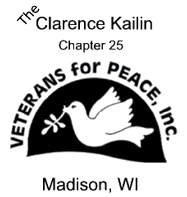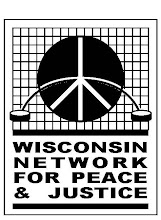What a title, only when you combine a legislative bureaucracy and an institutional bureaucracy.
Today I attended the Assembly Veterans and Military Affairs Committee on PTSD, I will be abbreviating as PTS since this is not a disorder and as mentioned by one of the speakers it is a normal result of the abnormality that the person deployed had been exposed to. The hearing was held due to the representatives valid concerns about 3200 members of the Wisconsin National Guard returning to the state around January. Although traditional veterans groups like the VFW and American Legion were personally invited I found out about the event from a fellow Veterans For Peace member who works in the media and was most likely alerted via press release. The stated purpose at the hearing was so that legislators had a firm understanding of the help available for PTS.
The first speaker was Dr. Dean Krahn who has this bio posted on the UW Psychiatry website: Professor of Psychiatry; Chief, Mental Health Service Line at VA-Madison and Director, Mental Health Service Line for the Great Lakes Network of VA. According to him due to recent outreach efforts and budget efforts years after the War of Terror began the VA mental health personnel around the country has increased 42 per cent since 2005. There are now double the people in Madison at 130.
The next speaker was Jean Bromley, MSW, OEF/OIF VISN 12 Lead and Milwaukee Program Manager. She highlighted the outreach done to reach veterans on campuses, at drill weekends, WDVA events like the Supermarket held in Marshfield recently. She also discussed the Post Deployment Health Reassessment (PDHRA) (Est. 2005) that is done 90 to 180 days post deployment to address concerns and provide care for the veteran. This is mandatory for all active and Reserve members, not for the Guard because of the dual role they have other assessments that I will discuss later and other speakers talked about. For Wisconsin there is the Yellow Ribbon Reintegration program that is 30, 60, and 90 days post deployment. At these events the veteran can enroll in VA health care. The USMC since this year has been holding IRR musters, which I couldn't find in any media but there is media of IRR musters for other reasons, to let them know about signing up for the VA and providing other important information for them. The focus of these different programs and gatherings is to provide tools and skills for reentry into civilian life. It seems that the word on the street that the Navy TAPS program is very good compared to Army and Marines is right otherwise they would only need to provide info on VA benefits and help getting them at these events. She went on to say that over 280000 service members/veterans had completed the PDHRA and over 104000 service members/veterans have been referred to a Vet Center of the VA. The top five diagnoses for servicemembers at these events, both men and women, are PTS, depression, back pain, knee/joint pain, and excessive tobacco usage. The ranking changes for the sexes but not the issues they are facing. To wrap up what I recorded for her comments, she mentioned that only half of those who were found to have PTS and referenced to a Vet Center or VA were getting care for PTS.
After these two speakers there were a few questions which were interesting. According to Dr. Krahn there are three ways that a veteran can receive care: Inpatient, Outpatient and via residential services. As part of inpatient care there are Community Based Outreach Centers or CBOCs, which he quipped is a popular acronym on CSPAN (too bad I don't have cable anymore since it is the only way to find out what is actually said nowadays with all of the news commentators instead of reporters). These CBOC can provide assessments and basically the same services as the VA for veterans who are not near a VA center just by billing the VA. There is also a rise in telemental health services being offered at CBOCs which was a concern in this 1999 report. This is a system where a $3000 camera/CPU device is used at a CBOC, and now at college campuses, which links the veteran to a VA where they can receive treatment without the trip from the rural area to the VA center. They said there was data that telemental health works as well as in person meetings but didn't say where it came from. The Uniform Services Package for Mental Health document mandates what the CBOCs must provide in terms of mental health help. From the new head of the VA, Shinseki, a directive has been created to determine whether the PTS treatment is working and making the symptoms lessen or worsening each time the veteran is seen. He is also directing outreach similar to that in Wisconsin to get veterans into the VA and building bridges with veterans. One concern with his directive on PTS and evaluating whether treatment is working or not is the BATTLEMIND program the Army is currently using. This training teaches resiliency and claims to be a way to avoid PTS but may be a way to teach military members how to shut down their brain when it comes to trauma just like they have been taught to do when it comes to killing. One comment at the end was a link between Porchlight and per diem housing to get a 20 unit place in Madison in the near future to serve homeless veterans.
Tracey L. Smith was the next speaker and described complex PTS as PTS from the childhood which is compounded by further trauma later in life. She said that there is no data on multiple deployments and the rate of PTS but only that the number of firefights is the factor which PTS increases and once a certain number is reach the PTS rate levels out. Also mentioned was that the high number of suicides but that they primarily occur in one or zero deployment members. She referenced an Institute of Medicine study from Oct. 2007 but all I can find online is that it was rather inconclusive regarding treatments for PTS. The VA is using large scale psychotherapy trainings and follow-ups for its personnel. Two therapies used are Cognitive Processing Therapy which is 12 - 1 hour session including where the veteran must write in detail their most traumatic experience and Prolonged Exposure Therapy which wasn't described that well. Their results show that OEF/OIF veterans get better results from the treatments than Vietnam veterans. She offered that it may be because they are receiving treatment sooner after the trauma. 7 out of 10 veterans refuse mental health services even if they are offered due to the stigma which besides the rural problem is a main concern when gettinng vets to come to the VA.
The next speaker was David Hosking, Global War on Terrorism Outreach Readjustment Counselor Madison Wisconsin Vet Center. He served for a total of 28 years and would probably still be in if allowed. He was in Vietnam and Iraq although was wearing a flight jacket with wings so I don't know what his MOS was. His talk was to read off the powerpoint slides and he seemed to like he had PTS or social anxiety, think Tom Smykowski from Office Space the people person. He talks to all units that demobilize through Fort McCoy to discuss the Vet Centers, CVSOs, Workforce Devlopment and other governmental programs available to veterans. One question from Rep. Hubler was about getting a call from a constituent who wanted help for a veteran loved one. He said that they should call the Vet Center and the Vet Center will set up and appointment for them in their locale.
Next up was Col. Kenneth Koon, Director of Manpower and Personnel at Wisconsin National Guard. He descibed a number of things including the Yellow Ribbon program, Battlemind, and resiliency Training as ways to help with trauma. In 2008 more National Guard members committed suicide thatn died in combat. According to him 60 per cent had never deployed.
The next speakers described the Veterans Court process, Krista Ginger (Public Defender) and Bil Klister (WDVA). These courts now exist in 7 states with New York the first in Buffalo started last year. In Wisconsin there is one in Rock County in VISN 12 and one to start in Eau Claire County in VISN 23 in the near future.
Following this there was questions about the telemental health services. They are springing up on campuses around the state. UW Plattteville was the pilot in Spring 2008 with 4 individuals receiving 7 sessions. In the Fall of 2008 there were 6 to 8 routine veterans receiving service. Later this fall UW Whitewater will start and UW Parkside and Oshkosh will follow. UW Eau Claire will be starting this fall but is under control of the Twin Cities VISN.
The session was then brought to a close.
My one question I jotted down early which was never answered except that we need to do more outreach is how to get past the VA stigma. When I first got into the VA and was getting physical therapy for my arm injury, thanks health insurance industry for forcing me to get socialized medicine, I was deeply depressed every time I had to go to the hospital. It is a very unwelcoming place to be. Also they never mentioned one alternative treatment that was available or that had been tested to be effective. One of their main talking points was that they want to focus on using what works as proven by research not what the practitioner thinks works or has been doing for a long time, so why no other methods besides their own?







